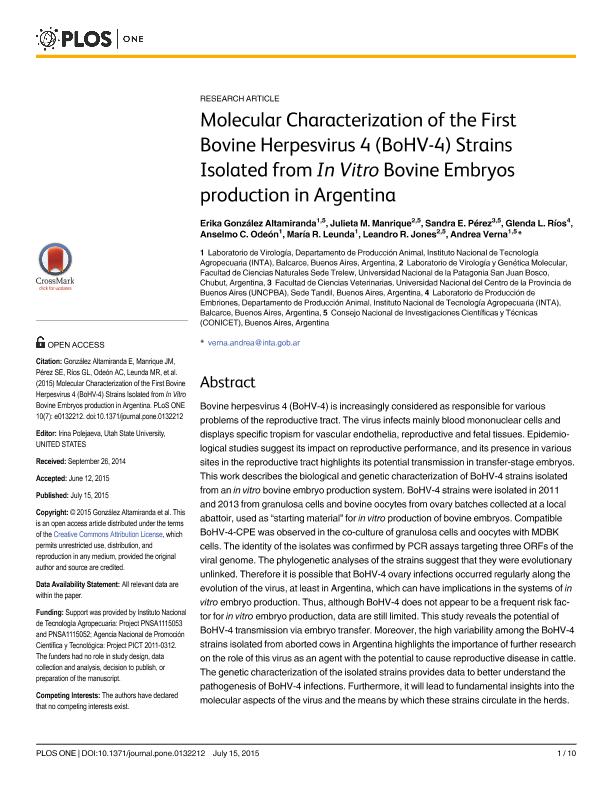Mostrar el registro sencillo del ítem
dc.contributor.author
Gonzalez Altamiranda, Erika Analia

dc.contributor.author
Manrique, Julieta Marina

dc.contributor.author
Perez, Sandra

dc.contributor.author
Rios, Glenda Laura

dc.contributor.author
Odeón, Anselmo Carlos

dc.contributor.author
Leunda, Maria Rosa

dc.contributor.author
Jones, Leandro Roberto

dc.contributor.author
Verna, Andrea Elizabeth

dc.date.available
2018-04-03T18:53:39Z
dc.date.issued
2015-07
dc.identifier.citation
Gonzalez Altamiranda, Erika Analia; Manrique, Julieta Marina; Perez, Sandra; Rios, Glenda Laura; Odeón, Anselmo Carlos; et al.; Molecular Characterization of the First Bovine Herpesvirus 4 (BoHV-4) Strains Isolated from In Vitro Bovine Embryos production in Argentina; Public Library of Science; Plos One; 10; 7; 7-2015; 1-10; e0132212
dc.identifier.issn
1932-6203
dc.identifier.uri
http://hdl.handle.net/11336/40548
dc.description.abstract
Bovine herpesvirus 4 (BoHV-4) is increasingly considered as responsible for various problems of the reproductive tract. The virus infects mainly blood mononuclear cells and displays specific tropism for vascular endothelia, reproductive and fetal tissues. Epidemiological studies suggest its impact on reproductive performance, and its presence in various sites in the reproductive tract highlights its potential transmission in transfer-stage embryos. This work describes the biological and genetic characterization of BoHV-4 strains isolated from an in vitro bovine embryo production system. BoHV-4 strains were isolated in 2011 and 2013 from granulosa cells and bovine oocytes from ovary batches collected at a local abattoir, used as "starting material" for in vitro production of bovine embryos. Compatible BoHV-4-CPE was observed in the co-culture of granulosa cells and oocytes with MDBK cells. The identity of the isolates was confirmed by PCR assays targeting three ORFs of the viral genome. The phylogenetic analyses of the strains suggest that they were evolutionary unlinked. Therefore it is possible that BoHV-4 ovary infections occurred regularly along the evolution of the virus, at least in Argentina, which can have implications in the systems of in vitro embryo production. Thus, although BoHV-4 does not appear to be a frequent risk factor for in vitro embryo production, data are still limited. This study reveals the potential of BoHV-4 transmission via embryo transfer. Moreover, the high variability among the BoHV-4 strains isolated from aborted cows in Argentina highlights the importance of further research on the role of this virus as an agent with the potential to cause reproductive disease in cattle. The genetic characterization of the isolated strains provides data to better understand the pathogenesis of BoHV-4 infections. Furthermore, it will lead to fundamental insights into the molecular aspects of the virus and the means by which these strains circulate in the herds.
dc.format
application/pdf
dc.language.iso
eng
dc.publisher
Public Library of Science

dc.rights
info:eu-repo/semantics/openAccess
dc.rights.uri
https://creativecommons.org/licenses/by-nc-sa/2.5/ar/
dc.subject
In Vitro Maturation
dc.subject
Bohv-4
dc.subject
Bovine
dc.subject
Argentine
dc.subject.classification
Otras Ciencias Biológicas

dc.subject.classification
Ciencias Biológicas

dc.subject.classification
CIENCIAS NATURALES Y EXACTAS

dc.title
Molecular Characterization of the First Bovine Herpesvirus 4 (BoHV-4) Strains Isolated from In Vitro Bovine Embryos production in Argentina
dc.type
info:eu-repo/semantics/article
dc.type
info:ar-repo/semantics/artículo
dc.type
info:eu-repo/semantics/publishedVersion
dc.date.updated
2018-03-28T18:12:20Z
dc.journal.volume
10
dc.journal.number
7
dc.journal.pagination
1-10; e0132212
dc.journal.pais
Estados Unidos

dc.journal.ciudad
San Francisco
dc.description.fil
Fil: Gonzalez Altamiranda, Erika Analia. Instituto Nacional de Tecnología Agropecuaria. Centro de Investigación en Ciencias Veterinarias y Agronómicas. Departamento de Producción Animal; Argentina. Consejo Nacional de Investigaciones Científicas y Técnicas; Argentina
dc.description.fil
Fil: Manrique, Julieta Marina. Universidad Nacional de la Patagonia "San Juan Bosco". Facultad de Ciencias Naturales - Sede Trelew; Argentina. Consejo Nacional de Investigaciones Científicas y Técnicas; Argentina
dc.description.fil
Fil: Perez, Sandra. Universidad Nacional del Centro de la Provincia de Buenos Aires. Facultad de Ciencias Veterinarias; Argentina. Consejo Nacional de Investigaciones Científicas y Técnicas; Argentina
dc.description.fil
Fil: Rios, Glenda Laura. Instituto Nacional de Tecnología Agropecuaria. Centro de Investigación en Ciencias Veterinarias y Agronómicas. Departamento de Producción Animal; Argentina. Consejo Nacional de Investigaciones Científicas y Técnicas; Argentina
dc.description.fil
Fil: Odeón, Anselmo Carlos. Instituto Nacional de Tecnología Agropecuaria. Centro de Investigación en Ciencias Veterinarias y Agronómicas. Departamento de Producción Animal; Argentina
dc.description.fil
Fil: Leunda, Maria Rosa. Instituto Nacional de Tecnología Agropecuaria. Centro de Investigación en Ciencias Veterinarias y Agronómicas. Departamento de Producción Animal; Argentina
dc.description.fil
Fil: Jones, Leandro Roberto. Universidad Nacional de la Patagonia "San Juan Bosco". Facultad de Ciencias Naturales - Sede Trelew; Argentina. Consejo Nacional de Investigaciones Científicas y Técnicas; Argentina
dc.description.fil
Fil: Verna, Andrea Elizabeth. Instituto Nacional de Tecnología Agropecuaria. Centro de Investigación en Ciencias Veterinarias y Agronómicas. Departamento de Producción Animal; Argentina. Consejo Nacional de Investigaciones Científicas y Técnicas; Argentina
dc.journal.title
Plos One

dc.relation.alternativeid
info:eu-repo/semantics/altIdentifier/doi/http://dx.doi.org/10.1371/journal.pone.0132212
dc.relation.alternativeid
info:eu-repo/semantics/altIdentifier/url/http://journals.plos.org/plosone/article?id=10.1371/journal.pone.0132212
Archivos asociados
